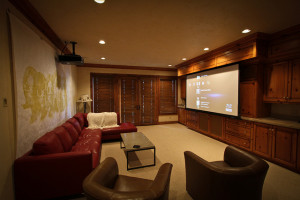Projector screens and the gain factor
 Every screen has a gain factor which determines which model you need.
Every screen has a gain factor which determines which model you need.
After you have chosen what type of projector screen, you need to consider the gain factor. Gain is a measurement of how much brightness is reflected off the screen’s surface compared to a standard white board. The way a screen surface refracts light is what differentiates one screen fabric from another.
A screen with a 0.9 gain only reflects 90% of the light while a screen with a 1.0 gain reflects 100% of the same amount. A screen with 1.5 gain reflects 50% more light and a screen of 2.0 gain reflects twice as much light.
That doesn’t necessarily mean the image will be twice as bright. The gain factor determines how much light is on the actual screen.
The first projector screens were grey in order to improve the levels of blacks shown. These negative gain screens don’t really make that much difference now with improved projector contrast ratios and black level.
The highest gain is not necessarily the best screen for you. Take into consideration the size of the room, lighting, projector being used conditions and content being shown. Review each type of gain to help you determine which screen to purchase.
1.0% Gain projectors
Room: Large or long rooms
Lighting: Some ambient light with light colored walls, ceilings and drapes. Light is reflected even when the lightings is turned off.
Image: Best for viewing digital photography, presentations and video images
Characteristics:
- Matte white
- Diffuses light evenly in all directions.
- Seating can be placed in a wide viewing angle
- All seats receive the same viewing experience regardless of the angle of view. .
- Colors remain bright with no shifts in hue.
1.5% High Gain White
Room: Smaller conference rooms and classrooms where seats can be positioned close together.
Lighting: Rooms with some light left on or with lots of natural light
Image: Video images, business presentations with graphics
Characteristics:
- Brightness of the image is not uniform. It increases the closer you get to the center.
- Hot spotting is common where the image disappears for those seated on the edges.
- Does not reflect green, blue and red equally so the color shifts in images are more noticeable when you change seats and view the image from different angles.
- Can’t be used with a ceiling mounted projector.
0.9% Gray screen
Room: Any size room
Lighting: Suitable for rooms with no ambient lights with dark walls and ceiling.
Image: Home entertainment, DVDs, videos, TV
Characteristics:
- Improves the levels of blacks shown by boosting contrast
- Not needed for projectors with high contrast ratios and black levels.
- Best for moderate output DLP projectors.
- High transmission and low reflection.
- Excellent color rendition and image contrast.
- Wide viewing angle.
- Best for true videophile

Leave a Reply